Although it doesn't have the breadth and depth of some competing services, Amazon Prime Music has the advantage of appearing to be free. Amazon Prime subscribers receive no-extra-cost 2-day shipping on many products purchased from Amazon, some streaming video is available without extra cost, and streaming music.
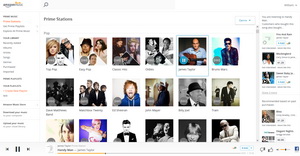
The interface looks a lot like that from other services except perhaps that Amazon Prime makes the purchase option a bit more prevalent.
Click any of the smaller images for a full-size view.
Press Esc to dismiss the larger image.
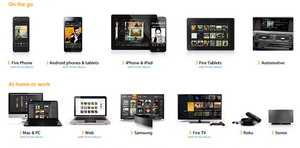
Users can upload their own music to the service, but the free offering allows space for just 250 selections. Uploading might be important to you because you won't find any online selections from Universal Music Group, one of the larger music publishers. Should 250 uploads not be enough, you can store 250,000 tracks for $25 per year.
Anything you've purchased from Amazon is available for listening, too, even if you haven't downloaded it to whatever device you're using to listen.
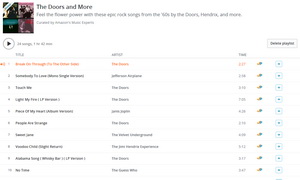
Amazon Prime Music has hundreds of themed playlists. Some are a bit strange in that they include an artist's lesser known, or unknown, recordings instead of more recognizable selections. Each playlist displays a track listing, the total runtime, and the name of the creator. If you like a particular track or and entire playlist, you can add the music to an area called Your Music Library.
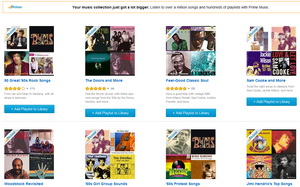
Many of the playlists run for at least an hour and some run for 4 hours or more, so if you're busy with something and don't want to be interrupted by having to keep making selections, you'll probably like them.
And, of course, there are no commercials -- on screen or interrupting the streaming content.
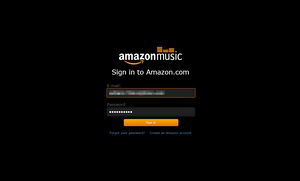
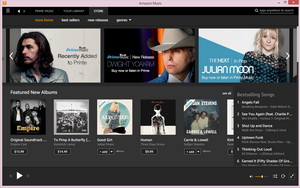
Controls consist of buttons for play/pause, previous track, and next track. In some cases, you can give a track thumbs up or thumbs down. Thumbs up tells Amazon that you want to hear more tracks like the one you're listening to. Thumbs down is the opposite, of course.
Over time, the system will learn your preferences.
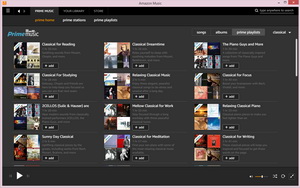
Amazon Prime Music isn't enough to justify a subscription to Prime ($100 per year), but if you already have Prime and you enjoy music, it's a handy addition.
File this under "not surprising". Global demand for tiny video cameras, whether worn or installed for surveillance, is increasing profits for companies that make the devices and pushing companies that haven't made the devices into considering new market opportunities.
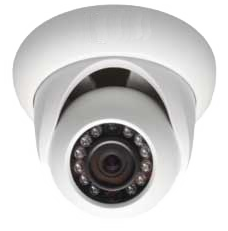 DirectView Holdings, for example, a company that has built hardware for security applications says that it plans to introduce a wearable camera within the next 2 months. The body camera will eventually be capable of connecting to a cloud-based storage system that DirectView is currently working on.
DirectView Holdings, for example, a company that has built hardware for security applications says that it plans to introduce a wearable camera within the next 2 months. The body camera will eventually be capable of connecting to a cloud-based storage system that DirectView is currently working on.
This is a rapidly evolving market and companies clearly see a chance to profit from plans by police departments in many cities to issue body cameras as standard equipment to police officers. Currently the number of manufacturers is small.
The United States has approximately 18,000 police departments, some with thousands of officers and others with just a few. Digital Ally and Taser International are working with about 3500 of those departments.
 Taser makes cameras that are small but still highly visible. Some models are small enough to be attached not only to a uniform but also to apparel such as sun glasses. Taser's cameras feature "Retina Low-Light technology" that enhances night vision.
Taser makes cameras that are small but still highly visible. Some models are small enough to be attached not only to a uniform but also to apparel such as sun glasses. Taser's cameras feature "Retina Low-Light technology" that enhances night vision.
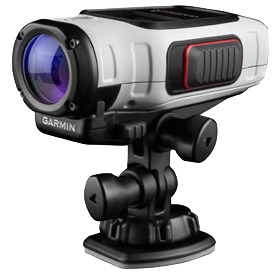 Garmin International, better known for its GPS gear, says it will soon be shipping compact cameras that can capture high-definition wide-angle images. The cameras will also be water resistant up to about 160 feet.
Garmin International, better known for its GPS gear, says it will soon be shipping compact cameras that can capture high-definition wide-angle images. The cameras will also be water resistant up to about 160 feet.
It's not only police who wear cameras. Those who enjoy extreme sports often use wearable cameras, too.
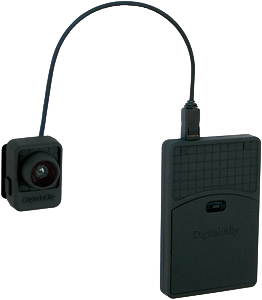 Digital Ally manufactures audio and video recording equipment that can be mounted in cars. Some of its cameras attach to the rear-view mirror and are designed for both law enforcement vehicles and commercial fleets.
Digital Ally manufactures audio and video recording equipment that can be mounted in cars. Some of its cameras attach to the rear-view mirror and are designed for both law enforcement vehicles and commercial fleets.
Body cameras were adopted by Danish police in 2005 and police in the UK began testing body cameras a year later. Evidence obtained from body cameras is considered useful by prosecutors and body cameras are now widely used in Europe.
In the United States, the interest has become more pronounced in the wake of police shootings, but police unions in New York City, Las Vegas, St. Louis, and elsewhere have opposed the adoption of body cameras.
Police union officials say the cameras will distract officers and say they're concerned about privacy.
This should also be filed under "not a surprise." The European Union is filing suit against Google, charging antitrust violations. If Google loses, it could see fines of $6 billion. That's enough money to make a difference even to a company as large as Google is.
The United States Federal Trade Commission conducted a similar investigation and decided that charges wouldn't stick. But there is a fundamental difference between Google in the US and Google in Europe. In the United States, Google is the largest search engine, but there is considerable competition. In Europe, Google has more than a 90% market share.
The European Union says that Google gives its own search results higher placement and that, as a result, more relevant links are sometimes far from the top of the results.
"Dominant companies can't abuse their dominant position to create advantage in related markets," is the way the EU's leading antitrust official, Margrethe Vestager, explained the charges.
But, as I noted, there's no surprise here. The European Commission has been investigating for 5 years. Last year, Google lost in a court case involving a European law that establishes a "right to be forgotten". The law requires Google to remove links on request. Google staged a major legal battle, but lost.
Google must respond to the new complaint within 10 weeks. If that response is anything other than an offer to stop doing what the European Commission objects to, the next thing to expect will be a very long court case.
Legislation is being considered by the House of Representatives to eliminate the Federal Communications Commission's net neutrality rules. The ruling made Internet service providers "common carriers", which they should have been from the beginning. The big trade associations have already filed suit and now some members of the House are trying to open a second front.
A "Resolution of Disapproval", introduced by Georgia Republican Doug Collins, is intended to use "fast track" powers under the Congressional Review Act to destroy the FCC's net neutrality rules.
The measure is likely to pass in the House, but it future in the somewhat more level-headed Senate is less certain. Collins says that procedural rules of the Congressional Review Act mean that the bill would need only a simple majority in the Senate. Still, if it passes both houses, the president could veto it. But a veto could be overturned by Congress.
It's a lot like a chess game. It's not like there are any more pressing problems for Congress to consider. And the National Journal noted this week that previous attempts to fast-track repeals of regulations "have largely been unsuccessful."
On a third front, this one also in Congress, the "Internet Freedom Act" promises to enforce a watered-down form net neutrality while limiting the FCC's power to regulate broadband. That seems more or less like telling your cat that it shouldn't eat the fish you left on the counter and then going out for the evening.
USTelecom filed suit almost immediately after the FCC formally published the new rules and the CTIA Wireless Association, National Cable & Telecommunications Association, and American Cable Association all piled on with suits of their own.
The ACA, which generally represents smaller Internet service providers, says that it supports net neutrality but disagrees with the FCC's classification of broadband as a "common carrier" service. The other organizations have filed suits to overturn rules that prohibit them from doing things that they say they don't do anyway.
Opera says that it plans to double its Android user base by 2017 from the current user base 130 million. The company is looking for 275 million users within 2 years and one reason they're expecting more business is the new Opera Mini browser.
This week Opera Software released a new version of the Opera Mini mobile browser with a redesigned interface that more closely matches Android's native look and feel. Two Opera browsers are now available for Android devices, Opera and Opera Mini. Expect a full review of the new browser after I've had an opportunity to use it for a while.
Android devices, of course, come with the Chrome browser installed, but other browsers are available for smart phones and tablets. These include Firefox, Maxthon, Dolphin, Puffin, and others you've never heard of. Opera claims more than 80% market penetration on Android devices and that, for a browser that must be explicitly downloaded by users, seems a bit high. On desktop and notebook systems, Opera's market share is usually less than 5%.
In releasing the new Opera Mini, Opera CEO Lars Boilesen said that doubling its user base by 2017 "will further cement Opera's position as a dominant browser in fast-growing, emerging economies."
Opera Mini has a simplified menu structure, a re-designed Speed Dial function, private-browsing mode, a modified browser layout that's "more thumb-friendly", enhancements to the built-in "Discover" news feed, and a scalable interface with higher resolution for tablets and large phones.